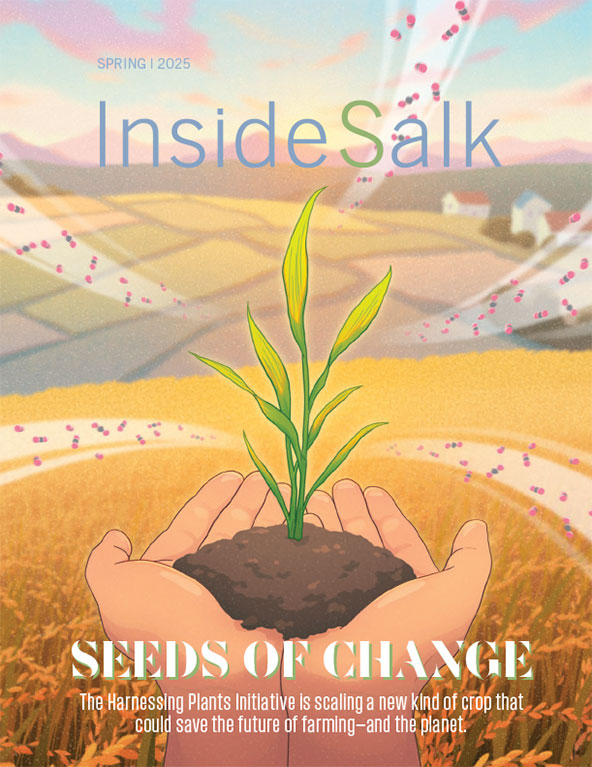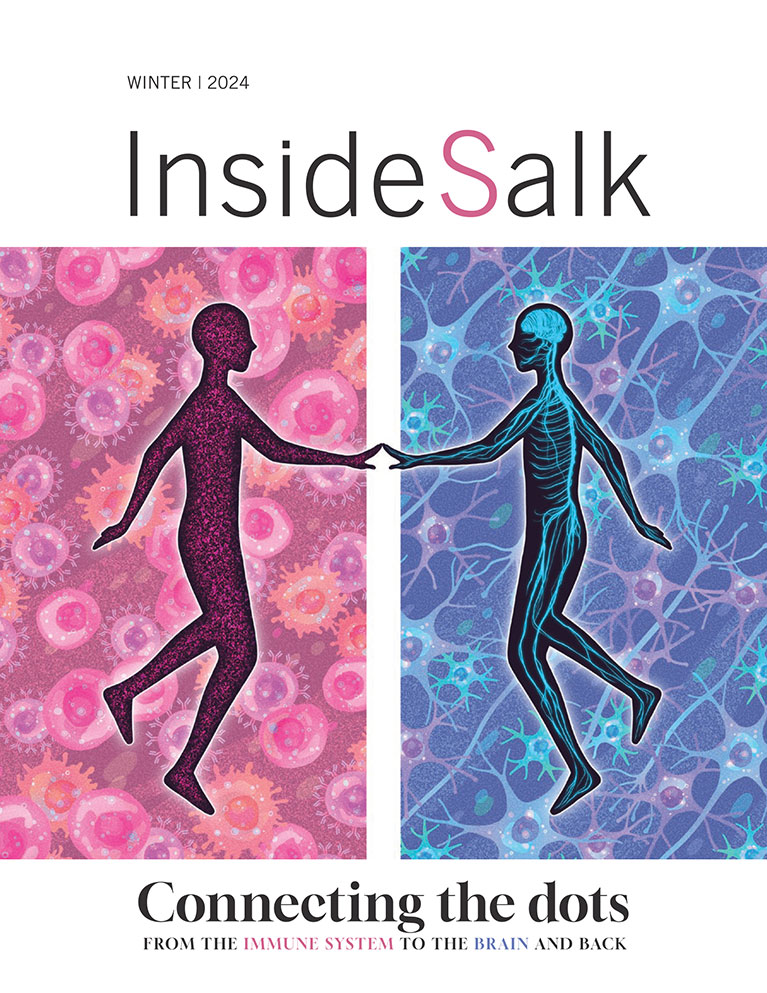Insights Carl Procko Lessons from carnivorous plants
One minute a fly is delicately exploring the interior surface of a crimson clamshell-like leaf, and the next minute—SNAP!—the clamshell closes and the unsuspecting insect becomes dinner for a Venus flytrap plant. As someone who studies carnivorous plants, that’s the type of high-stakes drama Staff Scientist Carl Procko sees every day.
By studying Venus flytraps and their close relatives, Sundew plants, Procko gains insight into the ultra-fast biochemistry of plants and how they can sense touch. It doesn’t hurt that these bug-eating plants are a great way to get kids—and adults—interested in science, Procko says. “A lot of people tend to not be very intrigued by plants in general, but it’s easy to get them hooked by bizarre plants that
do incredible things.”
PATH TO SALK
Procko didn’t always want to be a plant biologist. He grew up in southern Australia and went to college to study law. But classes in science—and then work in a biology lab studying embryonic stem cells—sidetracked him. He flew halfway around the world for graduate school at Rockefeller University in New York, where his research focused on how the nervous system of C. elegans worms develops. It was there that he learned the fundamentals of genetics.
“The nice thing about genetics is that the principles are translatable to just about any system,” says Procko. “Whether you’re studying worms or plants, you’re using similar technology to make genetic changes and test their effect on the traits of that organism.”
So, after graduate school, when Procko started looking for a change of pace, he knew he’d be able to apply that knowledge of genetics to a totally different type of organism—like plants.
DAY-TO-DAY
Like everyone else in the lab of Professor and Howard Hughes Medical Investigator Joanne Chory, Procko wants to know how plants respond to their environments. He is especially interested in leaves—the site of most photosynthesis in a plant.
To understand how different leaves have evolved, Procko compares the genetics and the gene activity of different plants and plant cells. He tests the roles of individual genes by mutating them and watching how a plant grows and responds.
In one recent study, Procko homed in on which genes are active in the trigger hairs of Venus flytrap leaves, which snap shut in response to prey. He discovered a new gene that he and his colleagues named FLYCATCHER1, or FLYC1 for short.
SPREADING SCIENCE
Procko is not only passionate about his own research projects, but also about hooking other people on science. Carnivorous plants make great ambassadors—even his three-year-old daughter becomes engrossed with his Venus flytraps, poking their at-home collection with grass and toothpicks to see what will happen. To help pique other people’s interest, Procko has taken his plants to events at the Fleet Science Center, and shown them off at Explore Salk days in the past.
“I think there’s a responsibility that comes with being an academic scientist to also do outreach,” he says. “It improves your own ability to communicate about your science at the same time as making the public more science literate.”
He is also an instructor at the University of San Diego and has developed a project for undergraduate students to analyze the collections of bacteria—or microbiomes—that live on and in carnivorous plants. “It’s a simple way for students to learn the basics of next-generation sequencing while also getting excited about plants,” Procko says.
FUN FACT
Procko is a twin, and his brother is also a researcher in the United States. The pair grew up exploring the beaches in Australia, watching David Attenborough, and making their own amateur documentaries about mangroves and the seashore.
“When you grow up as a twin, you grow up in the same environment and interact all the time, so it’s not too surprising that we ended up following similar paths,” says Procko.
His brother, Erik, studies protein structures and computational protein design at the University of Illinois and the two have had a few chances to collaborate—Erik was a co-author on the latest Venus flytrap paper, for instance, after helping Procko characterize the protein corresponding to the new FLYC1 gene.
LONG VIEW
While most plants don’t snap at flies, they do respond to touch—a tree’s trunk thickens in response to wind, for instance—so Procko’s research on carnivorous plants might help inform a better understanding of other plant systems.
More broadly, understanding how plants adapt to their environments and how they have evolved over time has implications for altering plants to yield better crops, adjust to global warming, or help combat climate change by drawing down excess carbon from the atmosphere.
“This is really important as environments are changing at the moment, and as we grow crops in areas that we typically haven’t before,” says Procko.
To that end, Procko is part of Salk’s Harnessing Plants Initiative, which aims to develop plants that can store more carbon in the ground, within their roots—this not only decreases carbon levels in the atmosphere, but also improves soil health. Since Procko’s current focus is on the leaves of plants, he’s especially curious how changing photosynthesis in the leaves might affect root growth.
Procko’s work could eventually have implications for human biology as well. One of his collaborators at Salk, Associate Professor Sreekanth Chalasani, is studying how the touch-sensitive proteins found in Venus flytraps might be genetically inserted into mammalian cells to make them sensitive to ultrasound simulation. This could make human cells that respond to ultrasound with any number of desired behaviors—increasing the production of a particular protein or medicine, perhaps.
“There are very cool potential applications for this work,” says Procko. “But there’s also just the joy of the basic science. At the end of the day, I do this research because it’s fun. It’s nice to go to work and be energized by what you’re doing.”
Support a legacy where cures begin.
Featured Stories
 Building a More Resilient WorldThe world is facing an array of health-related crises: COVID-19 and other infectious diseases, climate change, neurodegenerative conditions, cancers and many more. To tackle these daunting challenges, the Institute is embarking on a philanthropic campaign to focus on resilience: the biological adaptability that mitigates the effects of aging, resists disease and restores global wellness.
Building a More Resilient WorldThe world is facing an array of health-related crises: COVID-19 and other infectious diseases, climate change, neurodegenerative conditions, cancers and many more. To tackle these daunting challenges, the Institute is embarking on a philanthropic campaign to focus on resilience: the biological adaptability that mitigates the effects of aging, resists disease and restores global wellness. Susan Kaech – How T cells rememberSalk Professor Susan Kaech, director of the NOMIS Center for Immunobiology and Microbial Pathogenesis, has made it her mission to gain a better understanding of how T cells form, how they exchange molecular signals with the surrounding tissue, and how we can use this knowledge to prevent or treat infections.
Susan Kaech – How T cells rememberSalk Professor Susan Kaech, director of the NOMIS Center for Immunobiology and Microbial Pathogenesis, has made it her mission to gain a better understanding of how T cells form, how they exchange molecular signals with the surrounding tissue, and how we can use this knowledge to prevent or treat infections.
 Carl Procko – Lessons from carnivorous plantsStaff Scientist Carl Procko studies Venus flytraps and their close relatives, Sundew plants, to gain insight into the ultra-fast biochemistry of plants and how they can sense touch. It doesn’t hurt that these bug-eating plants are a great way to get kids—and adults—interested in science.
Carl Procko – Lessons from carnivorous plantsStaff Scientist Carl Procko studies Venus flytraps and their close relatives, Sundew plants, to gain insight into the ultra-fast biochemistry of plants and how they can sense touch. It doesn’t hurt that these bug-eating plants are a great way to get kids—and adults—interested in science. Nuttida Rungratsameetaweemana – Drawing from memoriesNuttida Rungratsameetaweemana, a Salk postdoctoral researcher who studies neuroscience, was introduced to the perplexities of the brain at age 14 during a chance encounter in a hospital waiting room.
Nuttida Rungratsameetaweemana – Drawing from memoriesNuttida Rungratsameetaweemana, a Salk postdoctoral researcher who studies neuroscience, was introduced to the perplexities of the brain at age 14 during a chance encounter in a hospital waiting room.



















































